
Sadly, none of CNJ's Pacifics survived. Nor did any of their M63 Mikados, another handsome Wooten firebox-equipped steam engine and the largest and most powerful steam power on the CNJ

CNJ was also a big proponent of the Camelback early on and had them in a large number of wheel arrangements, including the rarely-seen 4-8-0 "Mastodon"

They also ran high-stepping center cab Atlantics in commuter service right up to the end of the steam era

One of their 4-6-0s, #774, was the last Camelback in Class 1 service, being cleaned up and operated on fantrips to the end of '55. Railfan, photographer and writer Don Wood tried in vain to get CNJ to donate the #774 to a museum, but CNJ was not interested. They offered to sell it for $5000 (1956 money) and no one could come up with the money, so it was scrapped.

And then there were some very European-looking 2-6-2 tank engines that they used in commuter service early on, as they did not require turning around, but could be run in either direction. Built by Burnham, Williams & Co in 1902, they were gone by 1940

Replacing the 2-6-2Ts in commuter service were some very cool 4-6-4 Forney tanks. A Forney tank engine was was a configuration that mounted the cab over the last driving wheel and then a coal and water bunker mounted over the trailing truck. Never particularly popular in North America, CNJ, Boston & Albany and Canadian National were about the only lines to use them, all in commuter service

Sadly, despite the wealth of unusual steam engines, CNJ preserved very few. Always financially ailing, the CNJ needed every dollar they could get from scrap to dieselize in hopes of stemming the financial hemorrhaging. They donated only one steam engine: camelback 4-4-2 #592, which is now displayed at the B&O Railroad Museum

As mentioned, Don Wood tried to get them to preserve the #774, as it was the last Camelback in general revenue and the last CNJ steam engine on the property, but the CNJ essentially said that they had already done enough by donating the #592 and #1000, an unusual and very early Alco/GE/Ingersoll-Rand box-cab diesel switcher. And so #774 was cut up in '56.
One other CNJ steam engine survives, #113. One of their 0-6-0 switch engines, it was built by Alco in '23 and retired in '51, it was then sold to Philadelphia & Reading Coal & Iron Company, who used it at a colliery in Locust Summit, PA. The #113 would do a few fan trips with the #774 (must have been very slow ones, as the #113 would only do about 15mph tops) until the #774's scrapping, and then would continue to run on the property until 1960, when P&RC&IC retired it. It would sit outside deteriorating for the the next 20 years, before being moved to Wilmington and then moving again to Minersville, PA. From 1999-2012 it underwent an extensive restoration and now operates on occasional excursions over the Reading, Blue Mountain & Northern, as well as trips from Minersville.



CNJ #113 poking along on an excursion on the Reading, Blue Mountain & Northern. She definitely has an odd-sounding bell. It doesn't ring as much as make a dull metallic clang. The PRR 3-chime whistle is also great.
New York Central J-1 Hudson #5403 hammering across Illinois with a train headed for St. Louis. It's September 1954, and steam has been all but booted off of Lines East on the NYC and her days on Lines West are limited as well.

Much ado has been made over the NYC Hudson, but it's hard to grasp how impressive they were. When Paul Kiefer took over as the head of the motive power department in 1927, the standard passenger power was the K-series 4-6-2. But the K-2k was only capable of pulling 12 cars at a time, forcing the Central to either split trains in multiple sections or doublehead trains, neither of which was very efficient. So Kiefer added a trailing truck axle to install a larger firebox and created the Hudson, as well as making a number of other mechanical improvements that resulted in a passenger engine that could haul a 26 car train at 75mph with ease and haul 15 heavyweight Pullmans at a sustained 100mph. The later engines with "Centipede" tenders, with their 46-ton coal bunker, could go from NY to Chicago on a 16 hour time schedule with only a single stop for fuel and between Toledo and Elkhart the average speed was 74mph.

Since we're on the topic of NYC and their Hudson locomotives- the Dreyfuss streamlined J3a is, in my opinion, one of the classiest streamlined locomotives ever built.

NYC's 10 Dreyfuss-streamlined J3a Hudsons were the most impressive, not just in appearance, but performance. Reports indicate that these ran boiler pressures of 275psi when they were first built, but this made them so powerful that they kept bending connecting rods and the NYC was forced to back the boilers down to 250psi to keep them intact. This is likely the inaugural photo for the Empire State Express stainless-steel clad engine, as the stainless-steel skirting over the firebox was almost immediately removed for ease of maintenance.

This photo shows it without the stainless-steel skirt over the firebox. It is also using a regular black-painted "Centipede" long-range tender, instead of the Empire State Express stainless-steel clad streamlined tender.

In reply to NickD :
The last photo is southbound on the Hudson Line, just south of Breakneck Ridge between Beacon and Cold Spring. Today the area either side of the ROW is heavily overgrown, and the ridge is crawling with hikers, but otherwise it looks very similar.
As the NYC Hudsons and 4-8-2 Mohawks were overwhelmed by longer and heavier trains in the late 1930s, Paul Kiefer was called on to come up with a solution and he and the boys at Alco once again sharpened their pencils and dusted off their slide rules and began designing what is arguably the most impressive non-articulated steam engine in existence. A larger boiler was an easy way to make more power, but the NYC's old 15' tall tunnels (compared to 16' everywhere else) limited total boiler diameter. To take advantage of every inch, they deleted the steam dome off the top and instead used a perforated pipe inside the boiler to collect steam. This allowed them to make the boiler as large as possible without worrying about clearing the dome off of it in a tunnel. Similarly the smoke stack was made so short it was nearly non-existent. Boiler pressure was a staggering 275psi, feeding 25.5" × 32" cylinders and Baker valve gear. Lightweight materials were used in as many spots as possible and all of the rotating and reciprocating assemblies were precision-balanced and used roller bearings. To demonstrate the efficiency of roller bearings, the NYC even set up a demonstration where they had 4 female models in high heels pull the first engine, #6000, along the rails with ropes.
The first engine, class S-1a #6000, would be delivered in early 1945 with 75" drivers to convince the war production board it was a dual-purpose engine, as well as 290psi boiler pressure.
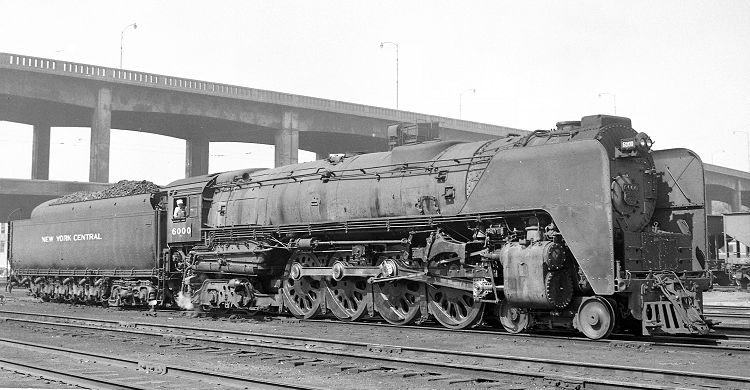
Another 25, class S-1b #6001-#6025, would be delivered after the war's end with 79" drivers for higher speeds. The #6000 would also be re-wheeled with 79" drivers and have its boiler pressure reduced to 275psi in a subsequent shopping.
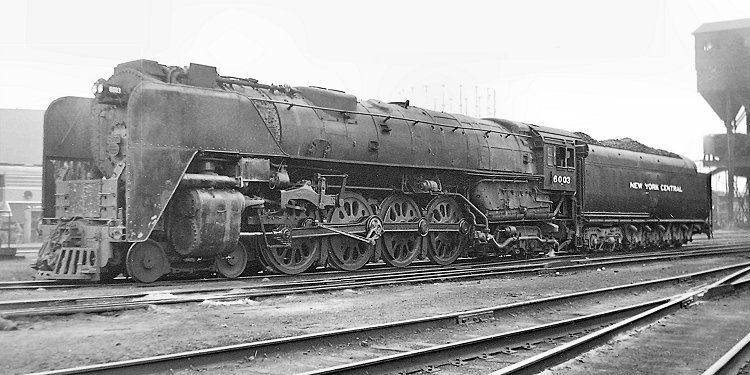
There was also a single S-2a, #5500, which would be the last steam locomotive delivered to the New York Central. It was identical to an S-1b, except it used an experimental Caprotti oscillating cam poppet valve gear that increased speed and efficiency but was so troublesome that the #5500 was the first Niagara to be retired in 1951, at only 6 years old.
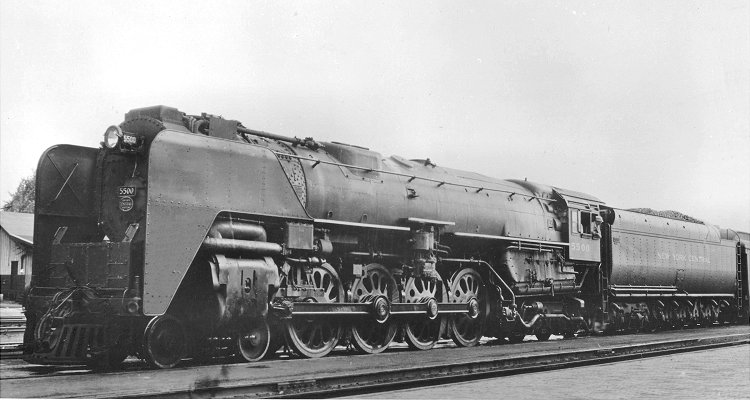
Shown here is ATSF #3460, the famed "Blue Goose". She was a streamlined Hudson (The only one so equipped in her class) with 84" drivers, developing boiler pressures of 300 lbs. Sadly, she was not preserved, and the only member of her class to survive is #3463, a non-streamlined Hudson on static display in Topeka, KS.


The Niagara, as they called these new 4-8-4s, were everything the Central could have wanted. They were fast , generated 30% more tractive effort than a Mohawk and were rated at 6000hp. They were head and shoulders above any other Northern in the areas of horsepower, and they were also better than any steam locomotive in the areas of weight per HP, availability, monthly and annual mileage, and total life cycle cost. As put by historian David Stephenson, in comparison to the PRR's T-1 4-4-4-4 Duplex "Here was a locomotive that could match the T-1 at all but the highest speeds, and do it day-in and day-out without special treatment. It was moderately sized and could go almost anywhere. It didn't require particularly deft handling, was very reliable, could operate in most types of service, and didn't require specialized maintenance."

The Central, making do with only 26 engines, kept them on the road constantly, with them accruing over 280,000 miles each in under a year. Because the Central scheduled them 6 days a week, they could not afford to let them sit and cool off for a day, so they instead came up with special asbestos suits to allow crews to work inside the boiler and firebox while it was still hot (the grates they were standing on were over 200 degrees) and get the maintenance done in a day.

Sadly, essentially as soon as they were delivered, the Niagara's time days were numbered. At the same time they were arriving on NYC property, so were EMD E7s diesels. In '46 a comparison of three EMD E7s versus a single Niagara was held and the results were much closer than EMD was comfortable with (and there are rumors that EMD and NYC management may have tampered with the results to make the diesels look better) but a coal miner's strike, aggressive sales pushes by diesel manufacturers, problems with the metallurgy in the firebox wrappers and NYC's reorganization under Perlman and Young in an attempt to make it a leaner, more efficient, modern-looking railroad spelled the end of them. The Niagaras began being retired in August of 1955, at only ten years old, as the firebox wrapper began to fail, and June 30th, 1956 marked the last passenger usage of #6015, and then #6015 made it's last freight run on July 2nd of 1956. None were saved.


They are doing track maintenance next to me today. This thing has spikes on hydraulic rams that drive down on either side of the tie, to loosen the gravel I guess?
Then a couple graders go by to reshape the gravel along the tracks.
After the Hudson and the Niagara, Paul Kiefer had one last round left in the chamber in terms of steam engine development. But unlike those engines, which became so famous, these slipped into obscurity.
After developing the Niagara, Kiefer turned his eye towards taking the lessons learned on the big 4-8-4s and applying them to a general freight engine in a 2-8-4 configuration. This takes some backtracking to understand the origin of the 2-8-4. At the end of WWI, the NYC found itself in need of faster freight engines. Lima produced a souped-up version of the NYC's H-class Mikados that met NYC's demands, operating at 35mph compared to the 20mph of it's predecessors. Looking to take it even farther, Lima decided to mount a 2-axle trailing truck on a 63" driver Mikado, allowing them to add a larger firebox and make a faster and more powerful engine. The NYC tested this engine and found it a solid performer, much better than the H-10 Mike, but Alco countered with a 69" driver dual-purpose 4-8-2 Mountain, the L-2 Mohawk, and the NYC went in that direction. But New York Central subsidiary, Boston & Albany, purchased 25 of these new 2-8-4s that were exact duplicates of the Lima demonstrator and put them to service, calling them Berkshires after the Berkshire Mountains that the engines worked. They would go on to purchase 30 more of these engines and they worked until 1949, before being retired when the Boston & Albany was dieselized.

The Berkshire blueprint would then be further modified by the Erie, who developed them into a 69" driver fast freight engine, and then Chesapeak & Ohio and Nickel Plate both perfected it. Sometime in the early-to-mid '40s, Paul Kiefer began tinkering with the design of the 2-8-4 Berkshire and decided to develop one with the 63" wheels of the B&A A-1a/b/c Berks but the "as large as possible" boiler design of the Niagara. Now, what the intended usage for these engines was is unknown and Paul Kiefer certainly is not able to answer that question these days. My guess, these were either designed to replace the again Consolidations and Mikados on the New York Central proper as medium-speed freight, or they were originally designed as a fast freight 69" or 73" driver engine and when the NYC decided to send them to subsidiary Pittsburg & Lake Erie, they were downgraded to 63" drivers to function better on that line. They also lacked the roller bearings and precision balancing of the Niagara and did not have a feedwater heater, instead using less efficient exhaust steam injectors. They did have overfire jets though, large air jets mounted over the fire level of the firebox that helped combustion at low speeds, which were an uncommon appliance (also supposed to be ridiculously loud and only semi-effective).
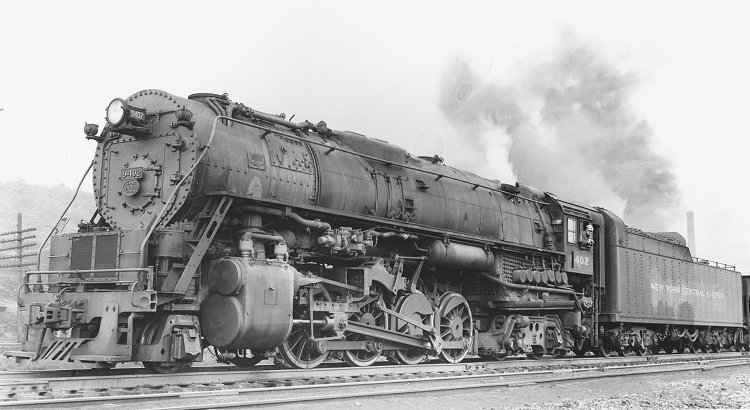
In 1948, Kiefer placed an order for ten of these A-2 Berkshires from Alco. But there was clearly a disconnect between the mechanical department and the management and shortly after the order was placed, they came down on Kiefer's head, wanting to know why the hell in the year 1948 were ten brand new steam locomotives being ordered when the New York Central was in the process of rapid dieselization. Construction had already begun on several of them, and so the NYC ended up keeping the order but backing it down to seven engines versus the original ten, all the while trying to figure out just what to do with these engines that they didn't want. So they decided to send them to the Pittsburgh & Lake Erie, whose short runs, level terrain and close proximity to coal mines meant they were not a good ROI for dieselization. Again, if I had to take a guess, these engines were originally to feature feedwater heaters, roller bearings and 69" or 73" disc drivers, and then the NYC stripped those accessories off to save money and had Alco downgrade them to 63" spoked drivers to operate better in the P&LE's drag freight operations.
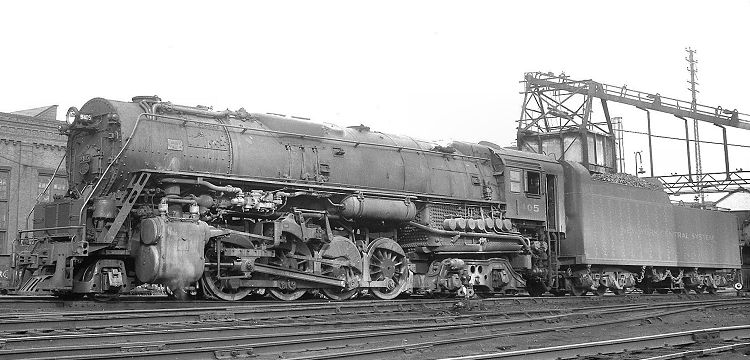
These 7 Berskhires ended up being the last steam engines that Alco built, and at this point Alco had pretty much wound down steam locomotive building and had to farm out production of many components. In fact, the tenders for them even ended up being built by Lima, who was still championing the steam engine at that point in time. Pittsburgh & Lake Erie was less than enthused about receiving these orphan steam engines, wanting to be dieselized. So in late '48, the A-2 Berkshires, painted in the traditional P&LE dark green with white lettering and driving wheels and bearing a strong physical resemblance to a NYC Niagara, arrived on the property.

There are few reports of how these engines performed, although they made a very respectable 67,000lbs of tractive effort, so they couldn't have been too bad. They were short-lived engines, with the P&LE retiring them in 1956, making them the shortest-lived modern steam engine design in America. They lived out their brief existences in relative obscurity, largely forgotten.

I am curious what these engines were originally intended for or if there were any changes to the design once the decision was made to send them over to the P&LE. I'm also curious why Paul Kiefer applied his boiler design to an all-new engine, rather than just adapt it to the already-successful Mohawk.
The steam locomotive with the highest tractive effort that saw common usage hauling freight was not, as you might surmise, the Union Pacific's famed 4-8-8-4 Big Boy. Instead, that title goes to the much more humble and unassuming Norfolk & Western Class Y6 2-8-8-2 compound Mallets. Built at N&W's vaunted Roanoke shops, the peak of the Mallet design found its home in the humble Y6b. It only had ~5500 HP at the drawbar, but the starting tractive effort was a staggering 152,206 lbs. The shops at Roanoke built such an effective locomotive that the N&W utilized them in daily operations until 1960, long after other railroads had turned to diesel. There were other, more powerful steam locomotives built, but none ever saw the production numbers or sheer usage of the Class Ys of N&W...

You'll need to log in to post.